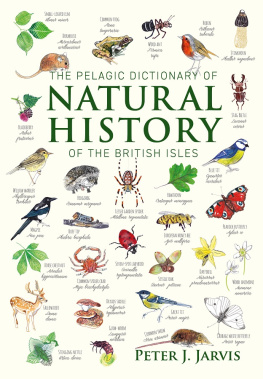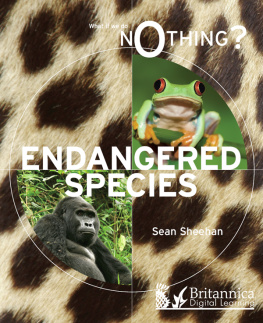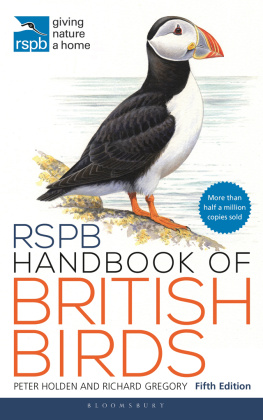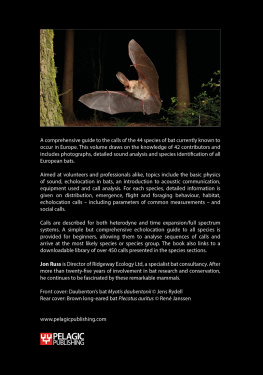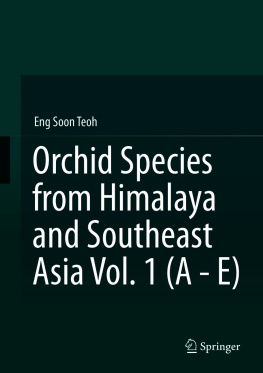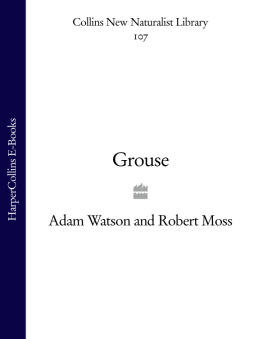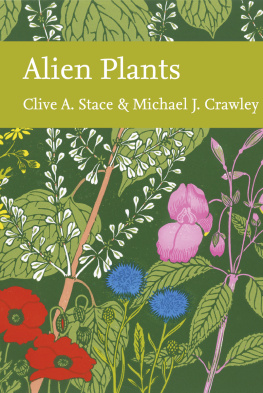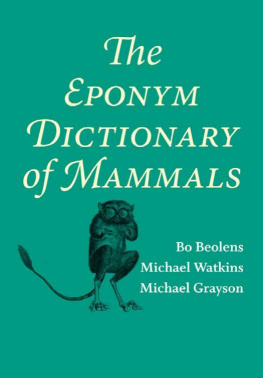


Published by Pelagic Publishing
PO Box 874
Exeter
EX3 9BR
UK
www.pelagicpublishing.com
The Pelagic Dictionary of Natural History of the British Isles
ISBN 978-1-78427-194-7 Hardback
ISBN 978-1-78427-195-4 ePub
ISBN 978-1-78427-196-1 PDF
Peter J. Jarvis 2020
The moral rights of the author have been asserted.
All rights reserved. Apart from short excerpts for use in research or for reviews, no part of this document may be printed or reproduced, stored in a retrieval system, or transmitted in any form or by any means, electronic, mechanical, photocopying, recording, now known or hereafter invented or otherwise without prior permission from the publisher.
A CIP record for this book is available from the British Library
Cover illustrations by Hennie Haworth 2020
In memory of
Nicky Jarvis 19752010
Contents
The dictionary provides information on the animals, plants, fungi and algae of the British Isles Great Britain, Ireland, the Isle of Man and the Channel Islands. It covers the taxonomy, habitat, distribution, abundance, status and, for animals, diet and size of individual species or species groups, with entries on those species that have English (common) names, and on many of the families, orders, classes, etc.
Even in the age of Internet search engines and hyperlinked web pages there is great value in an old-fashioned dictionary relating to the natural history of a region. This goes a bit further: it is an annotated dictionary which provides information that, together, is not found on single web sites. It goes beyond definitions, but it is not an encyclopedia. The book does not compete with field guides so there are neither verbal nor pictorial descriptions to aid identification.
And in some ways information on natural history or, rather, the words used in natural history is fighting a bit of a rearguard action. The 2007 edition of the Oxford Junior Dictionary , for instance, deleted a number of previous entries describing nature, examples being acorn, adder, ash, beech, bluebell, buttercup, catkin, conker, cowslip, cygnet, dandelion, fern, hazel, heather, heron, ivy, kingfisher, lark, mistletoe, nectar, newt, otter, pasture and willow. (Admittedly, room was understandably needed for such recent additions to common vocabulary as blog, broadband, bullet point, celebrity, chat room, committee, cut-and-paste, MP3 player and voicemail.)
This compendium provides an annotated snapshot of the biodiversity of the British Isles in the early twenty-first century. The regions biodiversity is changing dramatically: the order of magnitude of species is probably much the same as in the previous millennium but there has been a pronounced turnover in the British and Irish flora and fauna, with extinctions offset by arrivals through introduction and natural dispersal. Also, distributions and balances of numbers have shifted as species respond to human activities and (maybe much the same thing) climatic change.
This dictionary is in two main parts. The smaller Part I looks at various terms that people interested in natural history may come across. It consists of explanations of words and phrases that users of the main (organism) section might find useful. Inevitably it echoes information that is available in a number of other natural history dictionaries, but the terms included and their definitions are here geared to the organism entries, and on many of the families, orders, classes, etc.
Part II is on the organisms. Information is given on individual species or species groups, with entries on those with English names, and on selected families, orders, classes, etc. There are very few, if any, common or readily identifiable species that do not have an English name, so what is excluded are generally those that are taxonomically difficult or rare. In the case of marine organisms, entries are given for intertidal and subtidal invertebrate species, and generally speaking for fish and marine mammal species that might be observed inshore. A few entries are for diseases rather than the disease organism, for instance acute oak decline, ash dieback, Dutch elm disease, Lyme disease and myxomatosis, since these are the words an interested user would be looking for.
Entries are arranged alphabetically by primary name rather than by any qualifying adjectival name: thus all gobies are grouped together and collected under G for goby rather than separated under, for instance, B for black goby or C for common goby. Alphabetically arranged entries in the organism section also include the names of many families, all orders and all classes in Latin, and synonyms of common names.
There is information on around 10,000 species, including natives, introductions, and animals that are regular migrants and visitors. All British vertebrates are included mammals (101 species), birds (590), herpetofauna (30), freshwater and estuarine fishes (56), together with some coastal fishes. There are around 2,800 entries for invertebrates some two-thirds being for insects. Most invertebrates do not have common names, so for instance there are entries for only 84 of the over 250 species of bee found in the British Isles. All vascular plants are covered (2,950 species), as are all mosses (around 760), and liverworts and hornworts (288). About 1,000 of the 1,700 known lichen species are included, 1,410 of the 12,000 or so fungi , and some 50 macroalgae (i.e. seaweeds).
Each organism entry gives the Latin binomial and family (and sometimes subfamily) name. For vascular plants there is usually information on growth form (e.g. herb, shrub, tree) and life cycle (e.g. annual, biennial, perennial). Similarly, mosses are described as acrocarps (forming short cushions) or pleurocarps (free-branching), lichens as crustose, squamulose (scaly), foliose or fruticose, and liverworts as thallose (flattened, leafless) or foliose.
For all groups indication is usually given on distribution as well as whether a species is common, scarce or something in between inevitably rather vague, but arguably better than nothing. To the geographer, Great Britain refers to England (including the Scilly Isles), Wales and Scotland. The term United Kingdom refers to England, Wales, Scotland and Northern Ireland. The British Isles refers to the United Kingdom together with the Republic of Ireland, the Isle of Man and the Channel Islands. Britain, strictly, has no geographical (or political) meaning, but is in this dictionary somewhat guiltily used as a short-hand for Great Britain.
Distribution maps for the British Isles can be useful, but data varies according to survey effort, which in turn depends on where species are found (e.g. with less effort put into montane habitat survey than, say, in chalk grassland), taxonomic difficulty, and the number of experts undertaking survey work. It is true that maps are available for many species, for example those produced by the National Biodiversity Network and the Biological Records Centre, but these are often at a scale to give little more than a general geographical impression, and crucially often include all records, including those from some time back, and therefore no guarantee of current presence. In any case, there is also simply not the space in a book of this size and taxonomic scope for distribution maps at any scale, useful or otherwise.
For introduced species there is an indication of the region of origin, and often the period or, where known, date of introduction. Comments are generally given on whether such species have become naturalised (having self-sustaining populations) or appear as casuals (not persisting in the wild, and therefore dependent on repeated reintroductions).
Next page
